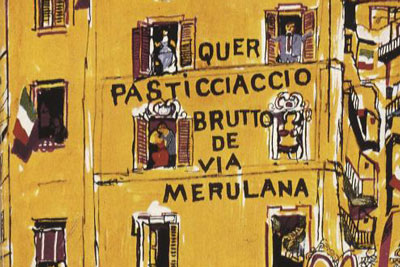Room 3
With the “sketch” published in Il Verri, The Engineer’s grandchildren and the De Feo house cat (1960), Alberto Arbasino coined an expression that succinctly conveys the complexity of a series of human and literary relationships that linked the “twenty-year-olds of the 1950s” to the writer Carlo Emilio Gadda. The three grandchildren who “came out more or less together around 1955, all hatching from Paragone” are Pasolini, Giovanni Testori and Arbasino himself. At that date Gadda “was already over sixty years old, had been writing for over thirty and had not yet published a volume of Il Pasticciaccio” and was considered by them to be “the greatest Italian author of the half century, to the immense spite of all the others”. In a vertical direction, Arbasino points to the debt owed to Gadda by his own generation who found in him the authorisation to follow their own linguistic experimentation in a literature freed from “every subjection and complex towards high ‘orders’ or ‘spheres’ in order to restore its dignity as an absolute linguistic operation”. It is, however, an indirect descent, not least because Gadda, an “elephant determined to die solitary”, never cared for his grandchildren – not sons – who were “cumbersome, obstinate to make him a sign of devotion” at times even “persecutory”. On the other hand, a shared “frenetic and imprudent vitality, always at risk” unites, in a horizontal sense, Pasolini to Testori and Arbasino: a “devouring obsession” that is a search for a language capable of rendering on the page the “most unleashed and experienced human passions”. This option of a relationship with reality that imprudently excludes censorship, “putting everything back into play, as if they were all going to die tomorrow”, leads them to choose a linguistic expressionism that takes into account different registers of writing, drafting and lexicon.
Reconsidering the three authors in this broader perspective of linguistic expressionism, it became clear how true is what Pasolini wrote about Gadda: “the problems that his language proposes on the page are not exhausted: they tend to become general. One cannot think of Gadda without thinking of the whole of the literary 20th century, nor of this without the particular 19th century that it potentially contains”.
And so it is that, moving even more freely in time, Mario Mondo constructs a large puzzle of writers who, to date, have chosen, in Contini’s words, a “very rich multilingual experience”. The first edition of Gadda’s Pasticciaccio (1957) and the Glossaries from Ragazzi di vita and Una vita violenta find their place in this enlarged perspective: a list of dialectal expressions, some of which then became commonly used.





